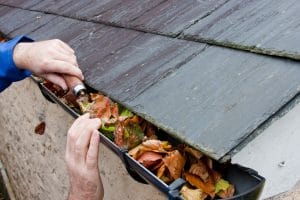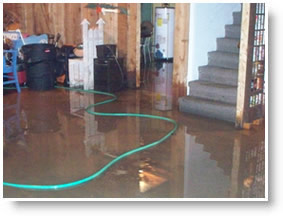Tips to Prevent Your Home from Flooding
Homes situated along flood plains are at risk for flooding—a predicable scenario. However, properties located away from flood plains are equally susceptible to floodwaters. Whether excess waters infiltrate your home via natural disasters or manmade ones, follow these best practices to prevent your home from floodingFlooding is the overflow or accumulation of water in areas t... More.
How are natural floods caused?

Residents are urged to prepare for the expected blasts of wind and rain.
Hurricanes, overflowed river banks and spring storms are natural calamities that force floodwaters into a home. Since rain falls on every inch of the globe, every home is at risk for floodingFlooding is the overflow or accumulation of water in areas t... More. FloodingFlooding is the overflow or accumulation of water in areas t... More can occur in an instant, without warning. At best, be prepared for the worst.
How are manmade floods triggered?
Broken appliances, like the washing machine or dishwasher, a malfunctioning water main, ruptured plumbing pipes and a host of various household calamities can inundate a home with a surge of water. The result is a hefty water damage repairRepair is the act of fixing or restoring damaged property, m... More bill.
In fact, each year households in the United States experience on average, $8.3 billion worth of flood damages, according to the National Oceanic and Atmospheric Administration. Homeowners who are proactive can avoid the watery mess and the associated financial setback.
1. Fix roof leaks.
Regularly inspect the roof for noticeable signs of water damage. Stains along ceilings and walls, moldMold is a type of fungus that grows in damp or humid conditi... More in the attic and black marks are indicative of a leaky roof. While fixing the actual roof leak requires little effort, pinpointing the exact location of the leak is the most challenging part.
Find the roof leak by partnering with a friend. One partner hoses water along the roof, while the other looks for penetrations from inside the attic. Once the leak is discovered, take steps to seal the leak with caulk or re-shingle the defective areas of the roof.
2. RepairRepair is the act of fixing or restoring damaged property, m... More plumbing leaks.
Leaky pipes are not only a nuisance but can leadLead is a heavy metal that can be toxic to humans, especiall... More to extensive water damage if left unaddressed. Homeowners know they have a leaky pipe in their midst when water pools in the basement. Other telling signs include buckling, visible condensation and rusted pipes.
Small leaks can be temporarily handled by homeowners until a licensed plumber offers a long-lasting solutionA solution is a homogeneous mixture of two or more substance... More. Adhere waterproof tape over the leak on the dry pipe. While the tape stops the leak for the short-term, another leak may spring up elsewhere. Call a plumber immediately for a permanent fix.
3. Maintain the gutter.

If your building’s gutters aren’t cleaned on a regular basis, you risk water leaking into the building through its roof or foundation.
A clean gutter performs its task efficiently. Homeowners should remove leaves and debris from their gutter system at least twice annually, once in spring and once in autumn. Installing leaf guards prevents the accumulation of debris. Ensure the gutter downspout extends 10 feet away from the home.
Though a gutter is out of sight and out of mind, the importance of maintenanceMaintenance is the routine care, inspection, and repair of a... More is clear. A clogged gutter sends a waterfall down the home’s siding, leading to a pool of water around the home’s perimeter. The foundation may begin to leak, leading to potential flooding in the basement.
4. Seal foundation cracks.
Excess moisture is responsible for cracks in the foundation. Every foundation displays trivial cracks. If either hairline or large cracks are noticeable along the foundation, take immediate steps to seal the flaws. Prompt attention only costs a few dollars and thwarts a pricey repairRepair is the act of fixing or restoring damaged property, m... More.
Minor cracks may be sealed with hydraulic cement or a vinylVinyl is a durable synthetic plastic material commonly used ... More concrete patching compound. Extensive cracks should be sealed with silicone or polyurethane caulk. Use a caulking gun to push the sealants into the cracks, letting the material dry, then reapplying a second layer.
5. Regrade the lawn.
This DIY project is due if the yard slopes toward the home. With a downward slope, the force of gravity allows water to pool around the home whenever wet conditions exist. Consequently, the basement stands at a high risk for floodingFlooding is the overflow or accumulation of water in areas t... More.
Add topsoil around the home and plant grasses to create a slope and ensure moisture is directed away from the home—not toward it. The best time to engage in regrading the yard is late summer or early autumn. When the winter season hits, the lawn should be adequately settled.
6. Replant the greenery.
Vegetation, like trees with aggressive roots, can weaken the strongest foundation and make it susceptible to damage and floodingFlooding is the overflow or accumulation of water in areas t... More. Plant pesky greenery, like maples and aspens, at least 20 feet away from the home. Consider removing troublesome shrubs and trees if they are located too close to the property.
7. Maintain the sump pumpA sump pump is a pump installed in a basement or crawlspace ... More.
Proper sump pump maintenance keeps floodingFlooding is the overflow or accumulation of water in areas t... More at bay. Regularly test the sump pumpA sump pump is a pump installed in a basement or crawlspace ... More. Take extra precautions and install a backup sump pumpA sump pump is a pump installed in a basement or crawlspace ... More in the event the electricity is cut or the pump is overloaded during heavy rains. If using a battery powered unit, keep the battery fully charged.
8. Install backflow valves.
When a sewer line is overflowed by floodingFlooding is the overflow or accumulation of water in areas t... More, the raw sewageSewage is wastewater containing biological and chemical cont... More water can back up the drain. The foul invasion can be prevented by installing backflow valves, which operate by blocking the pipes temporarily. As a result, sewer water has no path to re-enter the home.
Water Damage Restoration
Inspect your home periodically for signs of water intrusion. Routine walks through the basement and climbs into the attic help to foil catastrophic flood damage. If you do notice water stains and other signs of water damage, call a water damage restoration professional right away.
Water damage professionals are prepared to extract all excess moisture from your home and return it to a dry and habitable condition. Powerful air movers and dehumidifiers aid the restorationRestoration is the process of returning a property to its pr... More process. Sterilization is performed to cleanse the area of waterborne bacteria.
Flood damage is an emergency situation. Without prompt attention, water damage can cause structural damage and rot to the property and supply moldMold is a type of fungus that grows in damp or humid conditi... More sporesSpores are microscopic reproductive units of fungi or mold t... More with continuous nourishment. Prevent a mold problem and property damage by consulting a restorationRestoration is the process of returning a property to its pr... More professional as soon as the signs of water damage become evident.
The threat of a major flood is real for much of the U.S. during the spring and summer and the damage from a major flood can be devastating to your home. These flood preventionPrevention refers to actions taken to reduce the likelihood ... More tips will help you protect your home from floodingFlooding is the overflow or accumulation of water in areas t... More and limit the amount of damage if serious floodingFlooding is the overflow or accumulation of water in areas t... More does occur. If your home has been damaged by a flood despite your best effort, make sure you contact a water damage restoration professional as soon as possible. These professionals will stop the spread of the flood water and repairRepair is the act of fixing or restoring damaged property, m... More the damage with their advanced equipment.













